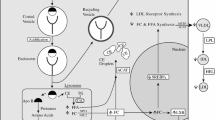Abstract
Background and aims
Lysinuric protein intolerance (LPI) is an autosomal recessive disorder characterized by defective transport of cationic amino acids lysine, arginine, and ornithine. Low plasma concentrations of arginine and ornithine lead to impaired urea cycle function and, subsequently, decreased protein tolerance. Patients often develop natural aversion to protein-rich foods, which may predispose them to nutritional problems. The objective of this retrospective study was to investigate lipid values and efficacy of lipid-lowering therapy in patients with LPI.
Methods and results
Serum total and high-density-lipoprotein (HDL)-cholesterol and triglyceride concentrations were analyzed in 39 Finnish LPI patients (14 males) aged 3–64 years. Dietary intakes were analyzed from food records. Mean [standard deviation (SD)] serum and HDL-cholesterol and triglyceride concentrations were 7.16 (2.13) mmol/l, 1.21 (0.58) mmol/l, and 4.0 (2.4) mmol/l, respectively. Patients with renal dysfunction had marginally higher total cholesterol and significantly higher triglyceride concentration than patients without renal impairment. Twenty-two patients were started on 3-hydroxy-3-methylglutaryl-coenzyme A (HMG-CoA) reductase inhibitors (atorvastatin or simvastatin). After 6 months, serum cholesterol and triglyceride concentrations had decreased by 32% (p < 0.001), whereas HDL-cholesterol had increased by 13% (p = 0.016).
Conclusion
Serum cholesterol and triglyceride values are markedly elevated in LPI patients. Although the mechanism of combined hyperlipidemia remains unknown and is not explained by fat consumption, hyperlipidemia is clearly progressive with age, suggesting that starting statin therapy early is probably beneficial. Statins are well-tolerated and efficacious in LPI.
Similar content being viewed by others
Abbreviations
- LPI:
-
lysinuric protein intolerance
- y+LAT-1:
-
System y+L amino acid transporter-1
- SLC7A7:
-
Soluble carrier, family 7, member 7
- NO:
-
Nitric oxide
- HDL:
-
High-density lipoprotein
- LDL:
-
Low-density lipoprotein
- BMI:
-
Body mass index
- HMG-CoA:
-
3-hydroxy-3-methylglutaryl-coenzyme A
- CysC:
-
Cystatin C
References
Athyros VG, Papageorgiou AA, Athyrou VV, Demitriadis DS, Pehlivanidis AN, Kontopoulos AG (2002) Atorvastatin versus four statin-fibrate combinations in patients with familial combined hyperlipidaemia. J Cardiovasc Risk 9:33–39
Folsom AR, Caspersen CJ, Taylor HC et al (1985) Leisure time physical activity and its relationship to coronary risk factors in a population-based sample. Am J Epidemiol 121:570–579
Friedewald WT, Levy RI, Fredrickson DS (1972) Estimation of the concentration of low-density-lipoprotein cholesterol in plasma, without use of the preparative ultracentrifuge. Clin Chem 18:499–502
Hakala P, Marniemi J, Knuts LR, Kumpulainen J, Tahvonen R, Plaami S (1996) Calculated vs. analysed nutrient composition of weight reduction diets. Food Chem 57:71–75
Harald K, Koskinen S, Jousilahti P, Torppa J, Vartiainen E, Salomaa V (2008) Changes in traditional risk factors no longer explain time trends in cardiovascular mortality and its socioeconomic differences. J Epidemiol Community Health 62:251–257
Juonala M, Viikari J, Hutri-Kähönen N et al (2004) The 21-year follow-up of the Cardiovascular Risk in Young Finns Study: risk factor levels, secular trends and east–west difference. J Intern Med 255:457–468
Kamada Y, Nagaretani H, Tamura S et al (2001) Vascular endothelial dysfunction resulting from L-arginine deficiency in a patient with lysinuric protein intolerance. J Clin Invest 108:717–724
Kovanen P, Pentikäinen M, Viikari J (2009) Dyslipidemiat. In: Välimäki M, Sane T, Dunkel L (eds) Endokrinologia, 2nd edn. Kustannus Oy Duodecim, Jyväskylä, pp 799–880
Mikkilä V, Räsänen L, Raitakari OT, Pietinen P, Viikari J (2004) Longitudinal changes in diet from childhood into adulthood with respect to risk of cardiovascular diseases; The Cardiovascular Risk in Young Finns Study. Eur J Clin Nutr 58:1038–1045
Niinikoski H, Lagström H, Jokinen E et al (2007) Impact of repeated dietary counseling between infancy and 14 years of age on dietary intakes and serum lipids and lipoproteins. The STRIP study. Circulation 116:1032–1040
Perheentupa J, Visakorpi J (1965) Protein intolerance with deficient transport of basic amino acids. Lancet 2:813–816
Raitakari OT, Rönnemaa T, Järvisalo MJ et al (2005) Endothelial function in healthy 11-year-old children after dietary intervention with onset in infancy: the Special Turku Coronary Risk Factor Intervention Project for Children (STRIP). Circulation 112:3786–3794
Schrott HG, Knapp H, Davila M, Shurzinske L, Black D (2000) Effect of atorvastatin on blood lipid levels in the first 2 weeks of treatment: a randomized, placebo-controlled study. Am Heart J 140:249–252
Simell O (2001) Lysinuric protein intolerance and other cationic aminoacidurias. In: Scriver CR, Beaudet AL, Sly WS, Valle D (eds) The metabolic and molecular bases of inherited disease, 8th edn. McGraw-Hill, New York, pp 4933–4956
Simell O, Perheentupa J, Rapola J, Visakorpi JK, Eskelin LE (1975) Lysinuric protein intolerance. Am J Med 59:229–240
Suschek CV, Schnorr O, Hemmrich K et al (2003) Critical role of L-arginine in endothelial cell survival during oxidative stress. Circulation 107:2607–2614
Tanner LM, Näntö-Salonen K, Niinikoski H et al (2007a) Nephropathy advancing to end-stage renal disease: a novel complication of lysinuric protein intolerance. J Pediatr 150:631–634
Tanner L, Näntö-Salonen K, Venetoklis J et al (2007b) Nutrient intake in lysinuric protein intolerance. J Inherit Metab Dis 30:716–721
Tanner LM, Näntö-Salonen K, Rashed MS et al (2008) Carnitine deficiency and L-carnitine supplementation in lysinuric protein intolerance. Metabolism 57:549–554
Acknowledgements
This study was supported by the European Genomics Initiative on Disorders of Plasma Membrane Amino Acid Transporters (EUGINDAT) and Sigrid Juselius Foundation, Finland.
Author information
Authors and Affiliations
Corresponding author
Additional information
Communicated by: Robert Steiner
Competing interest: None declared.
Rights and permissions
About this article
Cite this article
Tanner, L.M., Niinikoski, H., Näntö-Salonen, K. et al. Combined hyperlipidemia in patients with lysinuric protein intolerance. J Inherit Metab Dis 33 (Suppl 3), 145–150 (2010). https://doi.org/10.1007/s10545-010-9050-5
Received:
Revised:
Accepted:
Published:
Issue Date:
DOI: https://doi.org/10.1007/s10545-010-9050-5




